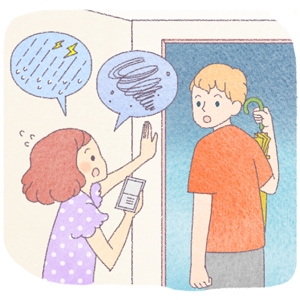Tokyo Life
Protect Yourself from Sudden Downpours, Lightning Strikes and Tornadoes!
*This article originally appeared on a website operated by Tokyo International Communication.
Louis is attending a Japanese senior high school while enjoying a homestay experience. Just as he is on his way out the door to visit a local library, he is pulled up by Sayaka, his host sister.

Sayaka
On this morning's weather forecast, the conditions for today were described as being unsettled. As such, if you plan to go out, you would be better off to carry an umbrella.
Louis
I see, thanks for the suggestion. Well look at that! The sky seems to have darkened rather quickly. I can also hear the rumblings of thunder. However, it still seems to be some way off. I'll head out now and try to beat it.
Sayaka
You'd be best to wait. The wind has also picked up, that's a sign of cumulonimbus clouds having formed in our immediate vicinity. I reckon we are about to experience a violent downpour. At such times, you also have to be careful because there is the risk of tornadoes and violent winds developing.
Louis
Really?
Sayaka
Let's have a look at the Japan Meteorological Agency website. Oh dear, they've issued a "Tornado Warning" for Tokyo and Chiba.
Louis
What should I do to protect myself if I become aware of a tornado in my immediate vicinity?
Sayaka
If you find yourself outside, it is recommended that you immediately relocate yourself and find shelter inside a solidly-built structure. If you find yourself inside, you should close all windows and draw the curtains. As much as possible, you should try and position yourself at the center of the structure. In that an oncoming tornado might shatter window panes, under no circumstances should you locate yourself close to windows.
Louis
Have a look outside! The rain is coming down in buckets!
Sayaka
With respect to sudden downpours, lightning and tornadoes that are brought on by cumulonimbus clouds, in many cases these conditions ease in around 30 minutes to an hour from their onset. As such, as much as possible it is a good idea to find somewhere safe and wait till the cumulonimbus clouds pass by.

Sayaka passes her smartphone to Louis.
Sayaka
When outside, if I don't like the look of the sky, I try and check the Japan Meteorological Agency's "Radar Nowcasts."
Louis
Radar Nowcasts? What sort of information is provided by them?
Sayaka
Using data gathered by weather radars, the service publishes predictive scatter maps regarding rain, lightning and tornado conditions up to one hour in advance. In other words, by looking at such information, it is possible to roughly predict in how many minutes squalls may become stronger, or in how many minutes conditions may ease. This information is updated every five to ten minutes.
Louis
I see! That sounds very convenient.
Sayaka
To prepare for the unexpected, it is also important to develop the knowledge you require to protect yourself. Because accidents occur annually due to the unexpected downpours, lightening and tornadoes, etc., brought on by cumulonimbus clouds, a disaster-prevention awareness video has been created and published by the Japan Meteorological Agency. Please make an effort to watch it.
Louis
This video also has English subtitles. I see. Right now seems like a great opportunity to watch the video and learn something while the weather outside settles.

- Japan Meteorological Agency
Tornado Warnings
http://www.jma.go.jp/jp/tatsumaki/ (in Japanese only)
Radar Nowcasts
http://www.jma.go.jp/en/radnowc/
Disaster Prevention-Awareness Video "Protect Yourself from Sudden Downpours, Lightning and Tornadoes!" (English subtitled version available)
http://www.jma.go.jp/jma/kishou/books/cb_saigai_dvd/index.html (in Japanese only)
